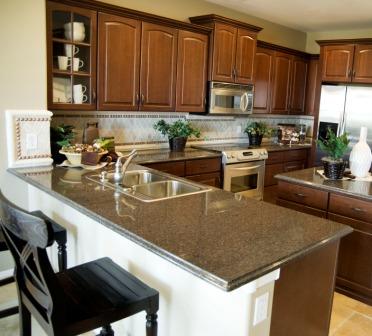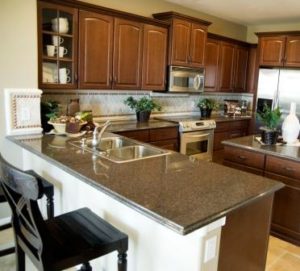Creating the Right Harmony With Your Countertop and Backsplash Choices

A big decision for any kitchen or bath is how to handle the backsplash—both in terms of function, and in selection in relationship to the counters and floors. If one considers that each material has a “voice”, than it gets a little easier to think of “harmony” in the space. Any voice should not dominate, and most importantly, no material should “scream”—or be overshadowed. Finding that balance isn’t impossible, but thinking a bit about what materials are saying really can help you decide!
Hard Surface Tops
A big ticket item, and a central selection, is the countertop. Incorporating this horizontal, smooth, hard surface with a variety of backsplash options in any sort of design is a balancing act of visual activity. For instance, a relatively ‘quiet’ pattern on the countertop will allow for a more dynamic pattern on the backsplash—in terms of tile color, size, shape and pattern. Hard, smooth, and relatively joint- line -free, typically shiny surfaces and also matte finishes look great with a variety of materials—metal tile or sheets, more of the same countertop material but perhaps in a tile form, glass tiles of all shapes and sizes, and of course, tile. It is also possible to specify a matte finish on your granite as well—not as common, but equally gorgeous and reminiscent of soap stone or slate finishes. Of course, solid surface materials are often matte finish and work well with most backsplash choices.
Natural Granite
It gets a bit trickier when dealing with granite tile on the countertop. A great option to get the beauty of granite without the custom cost of large slabs, granite tile and granite edges can be an excellent choice and a way to get a lot of bang for your buck. What can get challenging is the backsplash—generally with granite or marble, the joint or grout lines are minimalized in this type of installation, but visually, your mind will register pattern, even in the most “quiet” of granites. To mix in a backsplash of another material, it makes sense to consider perhaps a less active patterning in tile (colors and shapes), or consider sheet material such as metal, or a one color and simple patterning in tile.
Laminate surfaces
Laminate surfaces are often surprisingly beautiful and perform really well. (This is a typical reaction if you have always coveted a hard surface top and need to get savvy with your budget and selections!) Again, the backsplash plays a key role in giving your kitchen the voice and heft of a beautiful room . Tile generally is a good choice, but first consider having the integral or separate smaller backsplash in laminate on the wall for the standard 4”, then tile above. Why? From a functional standpoint, this joint between the horizontal countertop and the vertical wall is an important one—and gets a lot of wear, movement, and water over time. Mixing materials at that joint can sometimes be problematic—walls move, joints and grouts can pull away from the mixed materials, and over time this area can be compromised. Adding the secondary backsplash at a later date is also an option when budgets get tight. Meanwhile, a great wall color and adding decorative art can also add a little zest to the space.
From an aesthetics standpoint, the ‘voice’ of the laminate (rustic, contemporary, active, quiet) can then lead to good options in backsplash tile. Slicker laminates with shinier surfaces, contemporary edging and large or small patterns work well with shiny tiles—glass or ceramic. A naturally inspired laminate works well with introducing perhaps a secondary slate border and accent tile and rail above the 4” mark. This creates an overall 10-12” backsplash that doesn’t have to hit the full height of the backsplash (usually around 18’-21’). If you have the option, consider the heights of outlets in relationship to tile selections to avoid having your beautiful tile patterns interrupted.
Countertop edge details
Edge details on countertops also add to the composition—a more decorative edge in hard surface materials does add cost and a little more maintenance, but is a truly upscale and gorgeous look in a traditionally designed space. Laminate edges vary—full wrap edges look fresh and modern, and generally do not add much cost to the selection.
There are options and choices that will provide the function you need, the beauty you crave, at a budget you can live with—it just takes a little “listening” to all those “voices”! Be sure to research kitchen remodeling costs and their return on investment if you are planning a kitchen remodeling project.
Save
Save
Back

